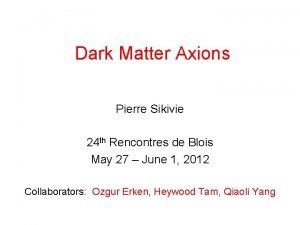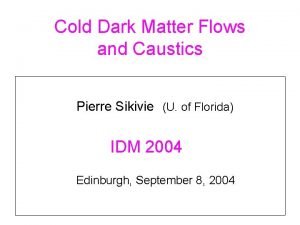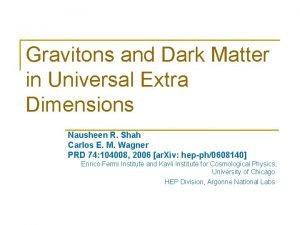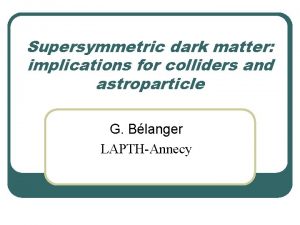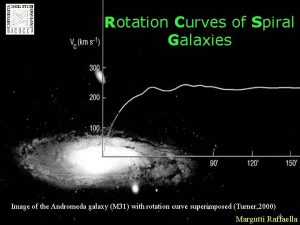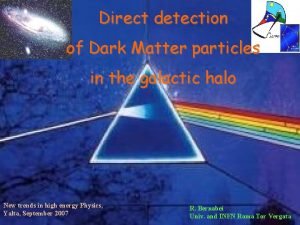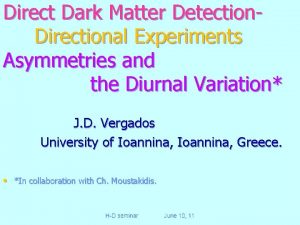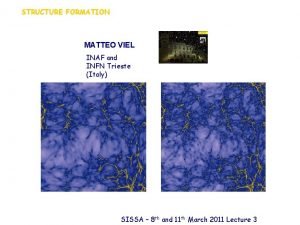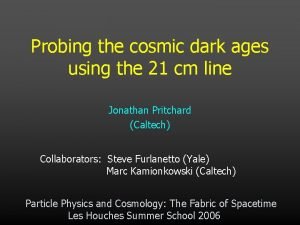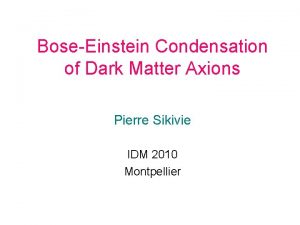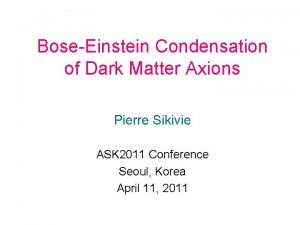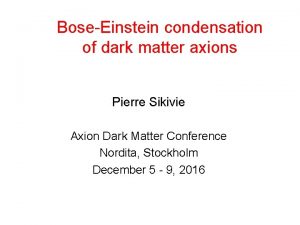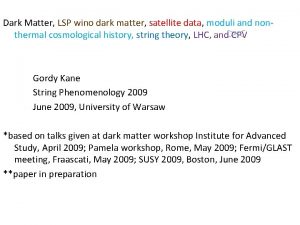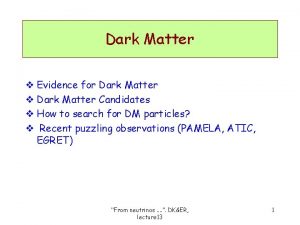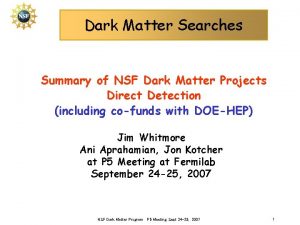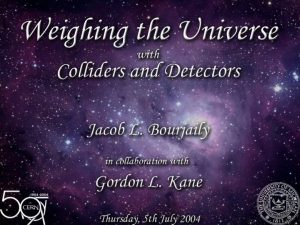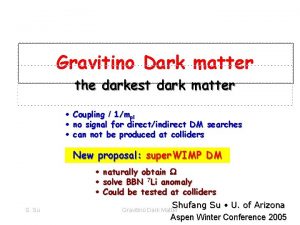Cold Dark Matter Flows and Caustics Pierre Sikivie

























- Slides: 25

Cold Dark Matter Flows and Caustics Pierre Sikivie (U. of Florida) IDM 2004 Edinburgh, September 8, 2004

Elucidating the structure of galactic halos is important for - understanding galactic dynamics - predicting signals for dark matter searches

Caustics in cold dark matter. . x x Dark matter particles are red and, on this page, they are free. d d x x

The cold dark matter particles lie on a 3 -dimensional sheet in 6 -dimensional phase space. the physical density is the projection of the phase space sheet onto position space z z

The cold dark matter particles lie on a 3 -dimensional sheet in 6 -dimensional phase space. the physical density is the projection of the phase space sheet onto position space z z

Phase space structure of spherically symmetric halos

Implications: 1. At every point in physical space, the distribution of velocities is discrete, each velocity corresponding to a particular flow at that location. 2. At some locations in physical space, where the number of flows changes, there is a caustic, i. e. the density of dark matter is very high there.

- the number of flows at our location in the Milky Way halo is of order 100 - small subhalos from hierarchical structure formation produce an effective velocity dispersion but do not destroy the sheet structure in phase space - the known inhomogeneities in the distribution of matter are insufficient to diffuse the flows by gravitational scattering - present N-body simulations do not have enough particles to resolve the flows and caustics (see however: Stiff and Widrow, Bertschinger and Shirokov)

Hierarchical clustering introduces effective velocity dispersion

A shell of particles, part of a continuous flow. The shell has net angular momentum. As the shell falls in and out of the galaxy, it turns itself inside out. . . .

A caustic forms where the particles with the most angular momentum are at their closest approach to the galactic center.

The caustic ring cross-section D-4 an elliptic umbilic catastrophe

On the basis of the self-similar infall model, the caustic rings were predicted to be in the galactic plane with radii was expected for the Milky Way halo from the effect of angular momentum on the inner rotation curve (I. Tkachev, Y. Wang + PS, astro-ph/9609022)

Composite rotation curve (W. Kinney and PS, astro-ph/9906049) • combining data on 32 well measured extended external rotation curves • scaled to our own galaxy

Inner Galactic rotation curve from Massachusetts-Stony Brook North Galactic Pane CO Survey (Clemens, 1985)

Spiral Arms vs. Caustic Rings of DM • What causes the rises in the inner rotation curve of the Milky Way? • Both spiral arms and caustic rings may contribute • However, here are some reasons to believe that caustic rings of dark matter are the main cause: - the number of rises between 3 and 8. 5 kpc is approximately 10, which is the expected number of caustic rings, whereas only 3 spiral arms are known in that range (Scutum, Sagittarius, and Local) - the rises are sharp transitions in the rotation curve, both where they start and where they end. The sharpness of the rises is consistent with the fact that the dark matter density diverges on caustic surfaces - bumps and rises are present in rotation curves at galactocentric distances much larger than the disk radius, where there are no spiral arms seen.

from W. B. Burton and W. W. Shane, 1970

Outer Galactic rotation curve R. P. Olling and M. R. Merrifield, MNRAS 311 (2000) 361

The Big Flow • density previous estimates of the total local halo density -24 range from 0. 5 to 0. 75 10 gr/cm 3 • velocity in the direction of galactic rotation in the direction away from the galactic center • velocity dispersion

Experimental implications • for dark matter axion searches - peaks in the energy spectrum of microwave photons from conversion in the cavity detector - high resolution analysis of the signal yields a more sensitive search (see talk by Darin Kinion) • for dark matter WIMP searches - plateaux in the recoil energy spectrum from elastic WIMP collisions with target nuclei - the flux is largest around December (Vergados; Green; Gelmini and Gondolo; Ling, Wick &PS)

Conclusions • Cold Dark Matter forms discrete flows and caustics. • The minimum set of caustics in a galactic halo is a series of simple folds located on topological spheres surrounding the galaxy plus a series of caustic rings (elliptic umbilics) in the galactic plane. • There is evidence that the locations of caustics are correctly predicted by the self-similar infall model. • That evidence implies that the dark matter in our neighborhood is dominated by a Big Flow.


Caustics of light at the bottom of a swimming pool on a sunny breezy day water surface pool bottom light intensity position

Caustics are common in the propagation of light (rainbows, the twinkling of stars, shimmering of the sea, gravitational lenses … ) because 1. light is collisionless 2. in many cases, the flow of light has small velocity dispersion

Caustics are rare in the propagation of ordinary matter because of collisions. On the other hand, cold dark matter 1. is collisionless 2. has negligible primordial velocity dispersion.
 Pierre sikivie
Pierre sikivie Pierre sikivie
Pierre sikivie What are caustics
What are caustics Dark matter and dark energy ppt
Dark matter and dark energy ppt Flow energy review
Flow energy review In the dark dark town
In the dark dark town Dark matter old gravitons dimensions
Dark matter old gravitons dimensions Boosted dark matter
Boosted dark matter Dark matter
Dark matter Dark matter pwo
Dark matter pwo Dark matter physics
Dark matter physics Where to stream dark matter
Where to stream dark matter What could dark matter be
What could dark matter be Dark matter
Dark matter Matteo viel
Matteo viel Dark matter
Dark matter Les houches dark matter
Les houches dark matter Grey vs white matter
Grey vs white matter Optic tract
Optic tract Gray matter and white matter
Gray matter and white matter Pallium telencephalon
Pallium telencephalon The cold war lesson 1
The cold war lesson 1 Section 1 composition of matter
Section 1 composition of matter Classification of matter section 1 composition of matter
Classification of matter section 1 composition of matter Chapter 2 section 1 classifying matter answer key
Chapter 2 section 1 classifying matter answer key Section 1 composition of matter
Section 1 composition of matter
